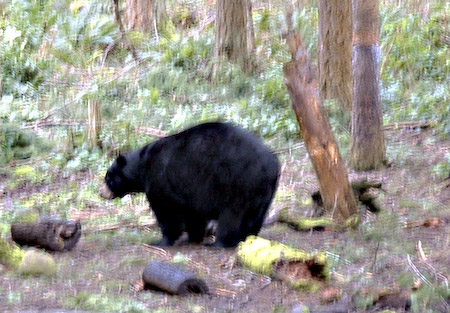|
The answer is BLACK BEAR.

The mystery tree as AMERICAN BEECH. For those
of you who don’t have beech in your region, it is identified by its
characteristic smooth gray bark. In regions where it grows, beech is
often the most important food source for black bears. In late summer,
bears eat beech nuts by the thousands to fatten up for winter. They are
so fond of beech nuts that they will climb trees 80 feet tall, go out as
far as they can on the branches, and break / fold the branches inward to
form what is known as a "bear nest", looking similar to the nest of a
gigantic bird. The bear doesn’t use the nest to lay in, though; it is
just a piling area for the food supply.
The tracks are approximately 3-7 years old, judging by the
dark-colored scarring as explained in Elbroch’s new "Mammal Tracks &
Sign" book.
Many folks guessed the tracks were from porcupine, which is a good
guess, as porcupines sometimes climb beech trees to feed on the bark.
Elbroch has good photos comparing bear tracks to porcupine tracks on
tree bark in his book [p. 613-614], which show finer claw size for
porcupine than bear.
Bears are said to most commonly climb trees by hugging the trunk with
their arms, and placing their hind feet flat against the centerline of
the tree. The hind claws don’t dig into the bark very much. So there is
tremendous force placed upon the sides of the tree by the front claws.
With such smooth, light-colored bark, that’s why beech trees display
such distinct tracks.
This quiz is one example of why knowing your trees helps you to
become a better tracker. Because the animals sure know their trees. In
the case of bears, I have learned they can distinguish between a beech
and an sycamore, between a white birch and a yellow birch, and between a
red pine and a white pine, for instance. |